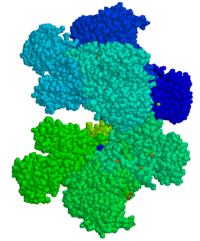
Photo from wikipedia
This study aimed to characterize the full-length cDNA of glucose-6-phosphate dehydrogenase (G6PD) from Megalobrama amblycephala with its responses to dietary carbohydrate levels characterized. The cDNA obtained covered 2768 bp with an… Click to show full abstract
This study aimed to characterize the full-length cDNA of glucose-6-phosphate dehydrogenase (G6PD) from Megalobrama amblycephala with its responses to dietary carbohydrate levels characterized. The cDNA obtained covered 2768 bp with an open reading frame of 1572 bp. Sequence alignment and phylogenetic analysis revealed a high degree of conservation (77–97%) among most fish and other higher vertebrates. The highest transcription of G6PD was observed in kidney followed by liver, whereas relatively low abundance was detected in eye. Then, the transcriptions and activities of G6PD as well as lipid contents were determined in the liver, muscle, and the adipose tissue of fish fed two dietary carbohydrate levels (30 and 42%) for 12 weeks. Hepatic transcriptions of fatty acid synthetase (FAS), acetyl-CoA carboxylase α (ACCα), sterol regulatory element-binding protein-1 (SREBP1), and peroxisome proliferator-activated receptor γ (PPARγ) were also measured to corroborate the lipogenesis derived from carbohydrates. The G6PD expressions and activities in both liver and the adipose tissue as well as the lipid contents in whole-body, liver, and the adipose tissue all increased significantly after high-carbohydrate feeding. Hepatic transcriptions of FAS, ACCα, SREBP1, and PPARγ were also up-regulated remarkably by the intake of a high-carbohydrate diet. These results indicated that the G6PD of M. amblycephala shared a high similarity with that of other vertebrates. Its expressions and activities in tissues were both highly inducible by high-carbohydrate feeding, as also held true for the transcriptions of other enzymes and/or transcription factors involved in lipogenesis, evidencing an enhanced lipogenesis by high dietary carbohydrate levels.
Journal Title: Fish Physiology and Biochemistry
Year Published: 2018
Link to full text (if available)
Share on Social Media: Sign Up to like & get
recommendations!